
The Hyborian Age

"Know, O prince, that between the years when the oceans drank Atlantis and the gleaming cities, and the years of the rise of the sons of Aryas, there was an Age undreamed of, when shining kingdoms lay spread across the world like blue mantles beneath the stars ... Hither came Conan, the Cimmerian, black-haired, sullen-eyed, sword in hand, a thief, a reaver, a slayer, with gigantic melancholies and gigantic mirth, to tread the jeweled thrones of the Earth under his sandaled feet." -- The Nemedian Chronicles

When Robert E. Howard began to chronicle the adventures of Conan the Cimmerian, more than forty years ago, he prepared a fictional history of the so-called Hyborian Age which he had created. That "history" dealt not only with the period during and after Conan's life, but also with events some eight thousand years earlier, during the Thurian civilization which produced King Kull, exiled warrior of Atlantis in the days before that continent sank into the surging seas.
The Pre-Cataclysmic Age (circa 20,000 BC)
Of that epoch known by the Nemedian Chronicles as the Pre-Cataclysmic Age, little is known except the latter part, and that is veiled in the mists of legend.
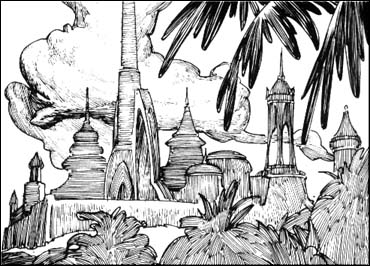
Known history begins with the waning of the civilization of the main, or Thurian continent... a civilization dominated by the kingdoms of Ramelia, Valusia, Verulia, Grondar, Thule and Commoria. These people spoke a similar language, suggesting a common origin. Though they don't seem to be in agreement. The barbarians of the age were the Picts, who lived on islands far out on the Western Ocean, the Atlanteans, who dwelt on a small continent between the Pictish islands and the Thurian continent, and the Lemurians, who inhabited a chain of large islands in the Eastern Hemisphere. There were vast regions of unexplored land, the civilized kingdoms, though enormous, occupied a relatively small portion of the whole planet. Valusia was the westernmost kingdom of the Thurian continent: her capital, the City of Wonders, was the marvel of her age. Grondar, whose people were less highly cultured than those of the other kingdoms, was the easternmost land. Among the less arid stretches of desert East of Grondar, in the serpent-infested jungles and among the snow-perched mountains, there lived scattered clans and tribes of primitive savages.
On the Far Eastern shores of the Thurian continent lived another race... human, but mysterious and non-Thurian, with which the Lemurians from time to time came in contact. They apparently came from a shadowy and nameless continent lying somewhere east of the Lemurian islands. Far to the South, there was a second mysterious civilization, unconnected with the Thurian culture and apparently pre-human in its nature.
The Thurian civilization was crumbling, their armies were composed largely of barbarian mercenaries. Picts, Atlanteans and Lemurians were their generals, their statesmen and often, their kings. Of the bickering of the kingdoms and wars between Valusia and Commoria, as well as the conquests by which the Atlanteans founded a kingdom on the mainland... there are more legends than accurate history.

Then the cataclysm rocked the world. Atlantis and Lemuria sank, the Pictish islands were heaved up to form the mountain peaks of a new continent, while sections of the Thurian continent vanished under the waves or sinking, forming great inland lakes and seas. Volcanoes broke forth and terrific earthquakes shook down the shining cities of the empires. Whole nations were blotted out and the face of the world was forever changed.
The Rise of the Hyborians (circa 17,000 - 15,000 BC)
When the great cataclysm caused the destruction of Atlantis and Lemuria, the inhabitants of the Pictish isles likewise perished. But a great colony of them, already settled along the mountains of Valusia's Southern frontier, were virtually untouched. Atlantis' kingdom on the main continent also escaped the common ruin, and to it came thousands of their tribesmen, fleeing in ships from the sinking land. Many Lemurians also made their way to the Eastern coast of the Thurian continent, only to be enslaved by the ancient race which already dwelt there. And their history, for thousands of years, became a story of brutal servitude.
In the Western part of the continent, thick jungles covered the plains, wild mountains were heaved up, and lakes covered the old cities in fertile valleys. Forced to battle continually for their lives, the Atlanteans yet managed to retain vestiges of their former state of advanced barbarism. Then, their struggling culture came into contact with the powerful Pictish nation. The stone-age kingdoms clashed, and in a series of bloody wars, the outnumbered Atlanteans were hurled back into savagery, and the evolution of the Picts was halted. Five hundred years after the cataclysm, the barbaric kingdoms had vanished.
To the far South, untouched by the cataclysm, is veiled in mystery, its destiny still pre-human. But a remnant of one of the non-Valusian civilized nations dwells among the low mountains of the Southeast. They are the Zhemri.
Meanwhile, in the far North, another people are slowly are coming into existence. A band of barely human savages had fled thither to escape destruction, they found the icy countries inhabited only by a species of snow-apes, whom they fought and drove beyond the arctic circle, to perish, as the savages thought. The primitive humans then adapted to their hardy new environment and survived.
Then, another lesser cataclysm further altered the appearance of the original continent and left a great inland sea to separate East and West. The earthquakes, floods and volcanoes completed the ruin of the barbarians, already begun by their fierce tribal wars.
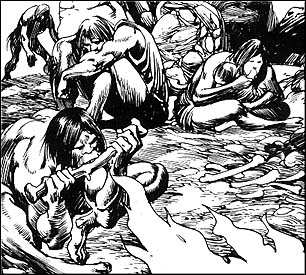
A thousand years later, wandering bands of ape-men exist without human speech, fire or tools. These are the descendants of the once-proud Atlanteans. To the Southwest dwell scattered clans of degraded cave-dwelling savages, primitive of speech, yet still retaining the name of Picts. Far to the East, the enslaved Lemurians have risen and destroyed their masters. They are savages, stalking the ruins of a strange civilization. The survivors of that civilization have come westward, overthrowing the pre-humans of the south and founding a new kingdom called Stygia. In the North, one tribe is growing: the Hyborians or Hyboai. Their god is Bori, some great chief whom legend has raised to the status of a deity. 1,500 years in the snow-country have made them a vigorous and warlike race. And now, they are pushing southward in leisurely treks.
A wanderer to the North at about this time returned with the news that the Northern icy wastes were inhabited by ape-like men, descended from the beasts driven out of the more habitable land by the Hyborians' ancestors. To exterminate these creatures, a small band of warriors followed him beyond the arctic circle. None returned.
And meanwhile, the tribes of the Hyborians drifted ever southward, to make the following age an epoch of wandering and conquest.
The Hyborian Kingdoms (circa 14,000 - 10,000 BC)

1,500 years after the lesser cataclysm which created the inland sea, tribes of twany-haried Hyborians have moved southward and westward, conquering and destroying many of the small unclassified clans. As yet, these conquerors have not come in contact with the older races. To the Southeast, the descendants of the Zhemri are beginning to seek to revive some faint shadow of their ancient culture. To the West, the apish Atlanteans have began the long hard climb back toward true humanity, while to the South of them, the Picts remain savages, apparently defying the laws of nature by neither progressing nor retrogressing. And, far to the South dreams the ancient, mysterious kingdom of Stygia. On its Eastern borders wander clans of nomadic savages already known as the sons of Shem, while next to the Picts, in the broad Valley of Zingg, protected by great mountains, a nameless band of primitives has created an advanced agricultural system and life.
Meanwhile, the first of the Hyborian kingdoms has come onto existence, the rude and barbaric kingdom of Hyperborea, which had its beginnings in a crude fortress of boulders heaped to repel tribal attack. There are few more dramatic events in history than the rise of this fierce kingdom, whose people turned abruptly from nomadic life to rear dwellings of naked stone, surrounded by cyclopean walls.
All this time, far to the East, the Lemurians are evolving a strange semi-civilization all their own, built on the wreckage of the one they overthrew. The Hyborians, meanwhile, have founded the kingdom of Koth, on the borders of the pastoral lands of Shem. The savages of the lands of Shem, through contact with the Hyborians and the ever ravaging Stygians, are slowly emerging from barbarism. Far to the North, the first kingdom of Hyperborea is overthrown by another tribe which, however, retains the old name. Southeast of Hyperborea, a kingdom of the Zhemri has come into being, under the name of Zamora. To the Southwest, invading Picts have merged the agricultural dwellers of the fertile Valley of Zingg. This mixed race in turn will be conquered by a roving tribe of Hybori, and from this mingled elements will come the kingdom called Zingara.
500 years later, the kingdoms of the world are clearly defined. The kingdoms of the Hyborians - Aquilonia, Nemedia, Brythunia, Hyperborea, Koth, Ophir, Argos, Corinthia and the Border Kingdom - dominate the Western world. Zamora lies to the East, Zingara to the Southwest of these. Far to the South sleeps Stygia, untouched by foreign invasions, though the peoples of Shem have exchanged the Stygian yoke for the less galling one of Koth. The Stygians have been driven South of the great river Styx, also called Nilus or Nile, which empties into the Western Sea. North of Aquilonia are the Cimmerians, ferocioius savages untamed by any invaders. Descended from the ancient Atlanteans, they are progressing more rapidly than their old enemies, the Picts, who dwell in the wilderness West of Aquilonia.
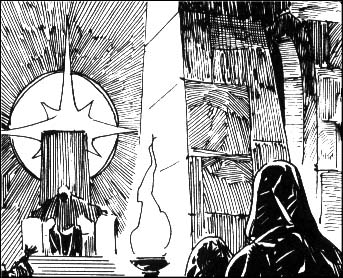
Another five centuries and the Hybori peoples are the possessors of a virile civilization, whose most powerful kingdom is Aquilonia, though others vie with it in strength and splendor. They are the supreme in the Western world. In the North, however, golden-haired, blue-eyed barbarians have driven the remaining Hyborian tribes out of all the snow-countries except Hyperborea. Their land is known as Nordheim, and they are divided into the red-haried Vanir and the yellow-haired Aesir. Now the Lemurians enter history again, as Hyrkanians. Pushing westward, one tribe establishes the kingdom of Turan on the Southwestern shore of the inland Vilayet Sea. Later, other Hyrkanian clans push westward around that sea's northern extremity.
Glancing briefly at the peoples of that age. The dominant Hyborians are no longer uniformly twany-haired and grey-eyed; they have mixed with other races, but this mixing has not weakened them. The Shemites are men of medium height with hawk noses, dark eyes and blue-black beards. The ruling classes of Stygia are tall men, dusky and straight-featured. The Hyrkanians are dark and generally tall and slender. The people of Nordheim retain their light skin, blue eyes and red or yellow hair. The Picts are the same type as they always were; short, very dark with black eyes and hair. The Cimmerians are tall and powerful, with dark hair and blue or grey eyes. South of Stygia are the vast black kingdoms of the Amazons, the Kushites, the Atlaians and the hybrid empire of Zembabwei. Between Aquilonia and the Pictish wilderness lie the Bossonian Marches, peopled by descendents of an aboriginal race mixed with Hyborians. They are stubborn fighters and great archers, as they must be to have survived centuries of warfare with the barbarians to the North and West.
This, then, was an "Age Undreamed Of", when shining kingdoms lay spread across the world like blue mantles beneath the stars.

This, then, was the age of Conan.
The Beginning of the End (circa 9,500 BC)
500 years after the time of King Conan, the Hyborian civilization was swept away while its vigorous culture was still in its prime. It was the greed of Aquilonia which indirectly brought about that overthrow. Wishing to extend their empire, her kings annexed Zingara, Argos and Ophir, as well as the western cities of Shem. Koth itself, with Corinthia and the eastern Shemitish tribes, was forced to pay Aquilonia tribute and lend aid in its wars. Nemedia, which had successfully resisted Aquilonia for centuries, now drew Brythunia and Zamora and secretly, Koth into an alliance against that western kingdom. But before their armies could join in battle, a new enemy appeared in the East. Reinforced by Hyrkanian adventurers, the riders of Turan swept over Zamora to meet the Aquilonians on the plains of Brythunia. Defeating the Turanians, the Aquilonians sent them flying eastward; but the back of the Nemedian alliance was now broken. The defeat of the Hyrkanians showed the nations the real power of Aquilonia.
Zamora was reconquered, but the people discovered they had merely exchanged an eastern master for a western one. Auilonian soldiers were quartered there, to keep the people in subjection as well as to protect them. In the North, there was incessant bickering along the Cimmerian borders between the black-haired warriors and their various neighbors, the Nordheimr, the Bossonians and the ever more powerful Picts. Several times, the Cimmerians raided Aquilonia itself, but their wars were less invasions than plundering forays.
But, by a strange quirk of fate, it is the growing power of the Picts in the West which is destined to throw down the kings of Aquilonia from their high places. At about this time, a Nemedian priest named Arus determined to go into the western wilderness and introduce to the heathen Picts the gentle worship of Mitra. He was not daunted by the grisly tales of what had happened to traders and explorers before him. Over the years, the Picts had benefited from contact with Hyborian civilization, but they had always fiercely resisted that contact. They dwelt in clans which were generally at feud with each other, and their customs were bloodthirsty and generally inexplicable to a civilized man such as Arus of Nemedia.
Arus was fortunate in meeting a chief of more than usual intelligence, Gorm by name, who gave him permission to remain among his tribe unbutchered. This was a case unique in the history of the Picts; and better for the flower of Hyborian civilization if Arus had been speared instead. Having learned the Pictish tongue, Arus harangued Gorm at length, expounding rhe eternal rights and justices which were the truths of Mitra. Being a practical man, Arus appealed to the savage's sense of material gain. He pointed out the splendor of the Hyborian kingdoms as proof of the power of Mitra. Arus spoke of wealthy cities and fertile plains, of jeweled towers and glittering armor. And Gorm, with the unerring instinct of the barbarian, passed over his words regarding gods and their teachings, and fixed on the material riches he so vividly described. There, in the mud-floored wattle hut, where the silk robed priest droned on the dark-skinned chief crouched in his tiger-hides, were laid the foundations of the Pictish Empire.
Fire and Slaughter (circa 9,500 BC)
Arus, priest of Mitra, had instilled in Gorm, the Pictish chief a desire to see the civilized lands. At Gorm's request, Arus conducted him and some of his warriors through the Bossonian Marches, where the honest villagers stared in amazement, and into the glittering outer world. Soon, Picts came and went freely into all Aquilonia. Arus no doubt thought he was making converts for Mitra right and left, because the Picts listened to him and refrained from smiting him with their copper axes. But what they really wished to learn from him and did, was how to mine the vast iron deposits in their hills and work them into weapons. With these, Gorm began to assert his dominance over the other Pictish clans.
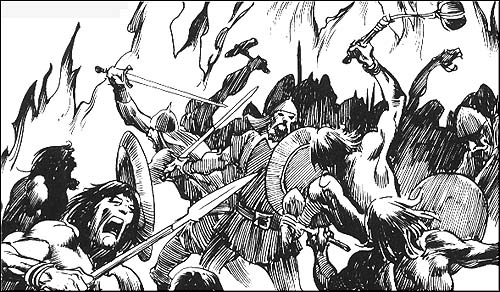
Aquilonia, meanwhile, pursuing her wars of aggression to the South and East, paid little heed to the vaguely known lands of the West, from which more and more stocky Pictish warriors swarmed to take service in her mercenary armies. These warriors, their service completed, went back to their wilderness with good ideas of civilized warfare and that contempt for civilization which arises from familiarity with it. As for Gorm, he became chief of chiefs, the nearest approach to a king the Picts had in thousands of years. He had waited long, he was well past middle age. Too late, Arus saw his mistake; he had touched only the pagan's greed, not his soul. And making a last effort to undo his unwitting work, he was brained by a drunken Pict. Gorm was not without gratitude; he caused the skull of the slayer to be set on top of the priest's cairn. The Picts burst upon the Bossonian Frontiers, clad not in tiger skins but in scalemail, wielding weapons of keen steel. Still, for years, the sturdy Bossonian Marches held the invaders at bay, thus keeping them from attacking Aquilonia itself.
Meanwhile, the Aquilonian Empire waxed strong and arrogance leading them to treat less powerful peoples, even the Bossonians, with growing contempt. Argos, Zingara, Ophir, Zamora and the Shemite countries were treated as subjected countries, which was especially galling to the proud rebellious Zingarans. Koth, too, was practically tributary and first Stygia, then Brythunia were defeated in battle. Yet, powerful Nemedia directly to the West had never been subdued. Thus, the Aquilonian armies moved at last against their neighbor state. Their glittering ranks however, were largely filled by mercenaries, especially the Bossonians. Because of the eastern war, scarcely enough men were left in the Bossonian Marches to guard the frontier. And hearing of Pictish outrages in their homelands, whole Bossonian regiments quit the Nemedian campaign and marched westward, where they defeated the Picts in a single great battle.
This desertion, however, was the direct cause of the Aquilonians defeat by the desperate Nemedians, and thus brought down on the Bossonians the cruel and shortsighted wrath of the Imperialists. Aquilonian regiments were brought to the borders of the Marches, and the Bossonian chiefs were lured into their encampment. There, the unarmed chiefs were massacred and the Imperial hosts then attacked the unsuspecting people. From North to South, the Marches were ravaged, and the Aquilonian armies marched back from the borders, leaving a ruined and devastated land behind them.
And then, the Pictish invasion burst in full power along those borders, led by Gorm, an old man now, but with the fire of his fierce ambition undimmed. This time there were no sturdy Bossonian warriors in their path, so that the blood-mad barbarians swarmed into Aquilonia itself, before her legions could return from the war in the East. Zingara seized this opportunity to throw off the yoke, followed by Corinthia and the Shemites. Whole regiments of mercenaries and vassals mutinied and marched back to their own countries, looting and burning as they went, while still the Picts surged irresistibly eastward. In the most of this chaos, the wild-born Cimmerians swept down from their Northern hills, completing the ruin, and the Aquilonian Empire went down in Fire and Blood.
The Darkness... and the Dawn (circa 9,500 BC)
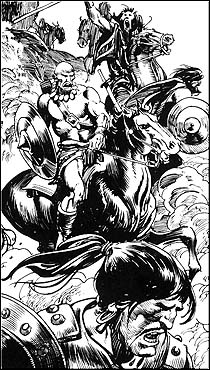
Following the collapse of the Aquilonian Empire, the Hyrkanian hordes came riding in from the East. Hyrkanians and Turanians together in time, united under one great chief. With no Aquilonian armies to oppose them, they were invincible, sweeping first over Zamora, then Brythunia, Hyperborea and Corinthia. Next, they swept into Cimmeria, driving the black-haired barbarians before them. But, among the hills, where the Hyrkanian cavalry was less effective, the Cimmerians turned on them, and only a disorderly retreat saved them from complete annihilation. The Picts, meanwhile, made themselves the masters of Aquilonia, massacring nearly all the inhabitants in the process. Probably only these fierce Pictish thrusts stopped the raging Hyrkanians from adding even Stygia to their widening empire. Nemedia, never before conquered, now reeled between West and East when a tribe of Aesir wandered South, to be engaged as mercenaries. Meanwhile, the Pictish chief Gorm, whose ambition had begun the slaughter, was slain by Hialmar, a chief of the Nemedian Aesir. 75 years had elapsed since he had first heard tales of the western lands from the lips of Arus, priest of Mitra. Long enough for a man to live, or a civilization to die.
For a short age, Pict and Hyrkanian snarled at each other over the ruins of the world they had conquered. Then began the glacial ages, and many nordic tribes were driven southward by the moving ice fields, driving kindred clans before them in turn. Nemedia, meanwhile, became a Nordic kingdom, ruled by descendants of the Aesir mercenaries. Pressed by the Nordic tides, the Cimmerians were on the march, destroying first Gunderland, then hewing their way through the Pictish hosts to defeat the Nordic-Nemedians and sack some of their cities. Then they continued eastward, overthrowing an Hyrkanian army on the borders of Brythunia. Hot on their heels, hordes of Aesir and Vanir swarmed South, and the newly founded Pictish Empire reeled beneath their strokes. Nemedia was overthrown, and the half-civilized Nordics fled before their wilder kinsmen, leaving the cities of Nemedia ruined and deserted. These fleeing Nordic-Nemedians broke the back of Hyrkanian power in Shem, Brythunia and Hyperborea, forcing the descendants of the Lemurians back toward the Vilayet Sea. Meanwhile, the Cimmerians, wandering southeastward, destroyed the ancient Hyrkanian kingdom of Turan and settled by the inland sea.
Their Western empire destroyed, the Hyrkanians butchered all unfit captives and herded thousands of slaves before them as they rode back onto the mysterious East. They would return thousands of years later, as Mongols, Huns, Tartars and Turks. Meanwhile also, red-haired Vanir adventurers came into Stygia, where they overthrew the reigning class and built up a vast southern empire which they call Egypt. From these red-haried conquerors the early pharaohs were to boast descent. The Western world was now dominated by Nordic barbarians. There were few cities anywhere; the once dominant Hyborians had vanished from the earth, leaving scarcely a trace of blood in the veins of their conquerors. In time, the whole history of the Hyborian age was lost in a cloud of myths and fantasies.
And then, another terrific convulsion of the earth hurled all into choas again, carving out the lands as they are known to us now. Great strips of the western coast sank, and the mountains of western Cimmeria became islands later called British. A vast sea, later called Mediterranean, was formed then the Stygian continent broke away from the rest of the world. The territory around the slowly drying inland sea was not affected, and the Nordics retreating there lived more or less at peace with the Cimmerians already present. In time, the two races became intermingled. In the West, the remnants of the Picts, reduced to the status of stone-age savages, possessed the land once more, till, in a later age, they were overthrown by the westward drift of the Cimmerians and Nordics. This drift resulted from a growing population which thronged the steppes West of the inland sea, now known as the Caspian and much reduced in size -- to such an extent that migration became an economic necessity. Known now as Aryans, these tribes moved into the areas now occupied by India, Asia Minor and much of Europe.
Some variations of these primitive sons of Aryas are still recognized today; others have been long forgotten since. The Nemedians of Irish legendry were the Nemedian Aesir, while the later sea-roving Danes were the descendants of the Vanir. The blond Achaians, Gauls and Britons were decended from the pure-blooded Aesir. The Gaels, ancestors of Irish and Highland Scotch came of pure-blooded Cimmerian clans. The ancient Summerians were of mixed Hyrkanian and Shemitish blood, while from the purer Shemites were descended both the Arabs and the Israelites. The Hyrkanians, retreating to the Eastern shores of the continent, evolved into the tribes later known as Huns, Mongols, Tartars and Turks before they bloodily re-entered Western history.
The origins of the other races of the modern world may be similarly traced. In almost every case, older far than they realize, their history stretches back into the mists of the forgotten Hyborian Age...
